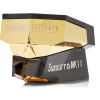SG210
|
“…The ability to extract low level information at low modulation levels, or to be unflappable at high modulation levels and not fall into chaotic behavior -- to sound strained and lose that tape-like quality -- is in part due to very low moving mass. Regardless of the reasons why the SG has these exemplary qualities, it has them. … … So, check it out yourself. This is the way to listen to your LPs, and hear them as you never have before. …” |
In early March I wrote a bit about changes imposed in part by the move to Ocala and a smaller listening room. Downsizing made sense, and the size of the system now is much more appropriate for the size of the room. Replacing Dunlavy SC-IV/As with Stirling Broadcast LS3/6 made sense. Going to an integrated amp made sense too, with fewer cables, and without the extra BTUs that would be unwelcome in my smaller upstairs listening room notwithstanding the friendly glow of filaments. I could listen to digital sources and I was pretty happy with the results.
But I have over 6000 LPs.
Good digital has been something of a revelation to me: generally, accurate timbres without time-based fluctuations (e.g., no wow from uncentered spindle holes, no warp-wow, no pressing defects...perfect sound forever!), ease and convenience of use. I have always found that, to some degree, playing vinyl is a bit of a crap shoot, by which I mean, despite good cartridges and phono stages, these things are having to do a pretty tough job (tracking, tracing, transducing, amplifying and equalizing), and sometimes it sounds it, like there's a struggle going on to fetch the music from the groove. Maybe you haven't felt this way, but results just seemed inconsistent to me, and perhaps more than occasionally so. This is suggestive to me of something on a hairy edge, beyond which somewhat chaotic behavior ensues. Even if that hairy edge is avoided on most LPs, digital seemed more, well, secure or dependable in a sense...
But then, I have over 6000 LPs.
While still in sunny South Florida, before packing up the system to move (and in fact, perhaps a year before that), I had stopped playing LPs. I had an airline leak that seemed to be at the compressor, so the Airtangent was belly up. Yeah, I could replace the compressor and whatever else that were responsible for the leak, but (news flash), I'm lazy, I just wanted to avoid the unpleasant hassle of being trouble-shooter/detective and successfully delayed/postponed/procrastinated until it was time to pack up and move. And, more than that, I was enjoying digital quite a bit, finding its pluses rewarding and rarely finding there to be minuses (I apologize for this bit of sacrilege, I'm not cut out to be a audio expert). But unable to spin vinyl was not a long term prospect that made me happy. Did I mention I have over 6000 LPs?
So, having left the old compressor to a friend in south Florida who felt competent to fix and use it, I eventually bought a replacement after the move. The line still leaked -- a lot. Maybe the old compressor wasn't the real culprit. Found a compressor expert in Ocala and brought in a couple things that are part of the airline (e.g., desiccant dryer) which required new gaskets and the sieve-like airline started to behave. And the Airtangent Reference was resurrected back to operational life. Likewise the VPI TNT-6X turntable as a whole.
As part of the downsizing, the phono stage, SUTs and the cartridges that use them were among the items removed from the system. Replacing all of that with something smaller and simpler was a no-brainer (well, not really: I contemplated this for months, but perhaps I'm a no-brainer?). What else but a SoundSmith Strain Gauge system (an SG-210, to be precise)? It took Peter Ledermann a few weeks to build it and its styli (Peter builds all of this by hand, and very precisely too). I think PL is not just a generous and gentle man, but one of the most formidable designers and manufacturers in high end audio. I don't think I'm alone is this assessment, either...but I digress.
Before I pulled to proverbial trigger, I concluded something that Peter mentioned to me later: that an arm like the Airtangent should work really well with the displacement-sensing Strain Gauge cartridge. At least, it should work well in theory: a non-skating arm, that as a result doesn't impose stylus displacement other than due to groove modulation, is ideal. Not that a pivoting arm cannot work well (as indeed Peter demonstrates the SG at shows), but AS adjustments are always a guess, and based on an average. Sometimes, for a particular record at a particular modulation level and radius, the result is nearly ideal, but not always. How much this matters I really don't know (but it probably matters somewhat less for a velocity sensitive cartridge, in so far as transduction is concerned, but not stylus wear of course). I do know that PL and Frank Schroeder more or less independently concluded and agreed that typical AS recommendations were too high, and FS shared his method to set AS that they recommend (and this can be found on the Sound-Smith website), but in theory none of this matters with a tangential/radial arm. And, I rather like the air bearing for damping and decoupling in any case, not to mention its low friction (oops, I just mentioned this :-)
So, I've had the SG-210 a little while now, and will admit that small adjustments can make a big difference, in particular with the SG-6 stylus which is the most demanding of the stylus shapes offered. Initially it was impressive, but a bit of fine tuning here and there have made definite strides forward. Peter sits at a microscope as he hand crafts the cartridge and styli, and he does it so well that initially adjusting things by sight (e.g., setting zenith and azimuth) gets you very close, and fine tuning from there is pretty easy.
Results?
Remember what I wrote above, that due to the tracking and tracing and transducing and amplifying and equalizing, it can sound like there's a struggle to get music out of the groove? This has lifted like a fog on a spring morning. It is hard to overstate this (but I will try ;-)
People like to say "tape-like" to describe exceptional results. My guess as to why is that there is both a smoothness and a clarity without rough spots when listening to a good tape. There's no sense of straining during demanding sections, of a diamond scraping along a groove, or inertial mass effects of any kind futzing with reading the modulation of the groove wall accurately. With a tape, there may be a bit of tape hiss, maybe even a bit of low level modulation noise that can obscure very low level sound though quality tape machines and matching tape formulations don't have much of this I think.
In contrast, there's a record in my collection that I've played for a very long time. Gerard Schwarz in his earlier life was a superb trumpet player (he was co-principal on the NY Philly for a couple years) and a founding member of the American Brass Quintet. On one side of this Desto set of 4 LPs, the ABQ play Ingolf Dahl's Music for Brass Instruments that I've loved (as a trumpet player in my youth) since first hearing it on a Kapp LP with Roger Voisin and Armando Ghitalla (but I think the ABQ on Desto is a better recording; too long ago to judge the performance on the Kapp LP). There's a very (very) soft passage at the end of one movement, for muted brass, that has always been almost unintelligible or indecipherable. Usually sounds like modulation noise, mucking things up. With the old system, as good as it was, this passage was very difficult, requiring turning up the volume and careful listening to discern just what was being played.
With the SG-210 (using the SG-6 optimum contour line contact stylus), these low level details are just clear as a bell (well, bells and mutes), and very tape-like (see above). But this remarkable clarity happens at any modulation level, from very soft (like the ABQ LP side) to very loud. One simply hears more of what otherwise is buried in those grooves. And the ease with which this is done is quite beguiling at first, and then just quite satisfying, instilling a quiet confidence that whatever an LP has to offer in both musical content and physical challenges, the SG will be your hero and save the day.
Recently I listened to the LaSalle Quartet performing the Schoenberg 3rd Quartet. I've owned this set since the early 70s, and have heard it countless times over the years. But not like this. To try to describe this would read like so many reviews over the years that really impart nothing useful other than the reviewer really liked it :-) Big deal. It's hard to describe the essential character of any component, though perhaps speakers and phono cartridges, which vary more than most things, can be described better than most things, if the writer isn't too full of himself and has real skills for the task. Let me try anyway.
What happened while listening, though, is what rarely happens to me except at live concerts, assuming good acoustics and an enthralling performance of some music that has the potential to really engage me. The beauty seduces me completely. Concerts I can remember like this include the Stockholm Philharmonic performing Boertz's first symphony (at that time, Daniel B. had only written one, which then was simply titled "Sinfonia" IIRC), the Julliard Quartet performing all the Beethoven quartets (in five concerts each leaving me floating on air), and the Cleveland Orchestra under Pierre Boulez performing Debussy, De Falla and Stravinsky (the Rite, a week before they went into the studio to record it for Columbia records). There are others, like the New World Symphony performing Ravel's Daphnis et Chloe. I became so stuck, so immersed, so focused, that nothing else existed during that time. When it ended, the state of profound relaxation and exhilaration (joy?) was about as yummy an experience as I can imagine.
I was having that same experience listening to the quartet. Each part was beautifully played, nuances of each performer playing off the others in a way that makes the music breathe with life. Because so much low level/subtle information is there, the instruments are more "there", more palpable and more of real flesh (as it were), and the performance more real as a result. I'm not saying it's the same as a live performance, of course, but there's a lot more in the vinyl than I have heard before, and the performance captured better than previous listenings ever hinted of. (I should remark here, I suppose, that part of hearing the excellence of the SG is due to the rest of the system as it is now constituted, not the least of which are the remarkable LS3/6 monitor loudspeakers! High resolution, indeed!)
It seems important to underscore that all the detail resolved is so much of the musical fabric, so well integrated into the whole, that one isn't aware of this exactly as detail, per se. With really good source material, it is a joy, but even with less exemplary material, the SG doesn't exaggerate or exacerbate flaws of the recording, or even of the physical disc itself, and this allows these recordings to be enjoyed on their own terms.
I've read comments elsewhere that the SG is not accurate in tonal balance. I beg to differ, and feel if anything, it is very natural in rendering timbre, and this combined with its other considerable strengths, of low moving mass and very high resonant frequency, and minimal electronic processing from cartridge pins to line output, offer a performance envelope that is more revealing and more, uh, tape-like. And in multiple senses, the SG is less wearing. Peter has a lacquer master that he has played many times, and with so little accumulated wear that it still sounds like a virgin lacquer, according to some comments I read. (I haven't had the pleasure, personally.) Certainly interesting if true, eh?
What about mono recordings? Oh, I'm so glad you asked.
Playing mono records with a stereo cartridge is not optimal, as we all know from experience. Stylus geometries may need to be different, and vertical information from rumble in the disc or other sources need to be ignored, as these detract and distract. But, I have played a few mono LPs of pre and post stereo eras and the usual problems, of playing mono with stereo cartridge (even when channels are summed to mono), have not yet been an issue. I do have a couple other styli for the SG, including one (a nude elliptical) intended for mono records, to minimize noise from worn mono grooves, but have not yet felt the need to swap stylus assemblies (oh yes, did I forget to mention the SG features user replaceable styli?). I'm purely on my own with this one (I haven't read PL comment on why the SG does well with mono LPs), but I would guess that some of the artifacts usually encountered in playing monos with magnetic cartridges is that they are not quite as dynamically (in a system sense) stable and the SG just doesn't bat an eye with such encounters. But I'm shooting from the hip on this one.
[I wrote to Peter L. about why mono LP playback is so effective with the SG, and without quoting him here, he indicated that the very well balanced channels, very low mass and low stored energy of his SG design, allow the two channels to have very closely matched output that cancel very effectively when summed electrically, or if not summed electrically, cancel quite well acoustically. I think we're talking about vertical signal generating artifacts in mono records, which ideally would only have lateral/horizontal information present.]
I think the notion of stylus jitter makes sense here, which is that 'chaotic behavior' that I alluded to. Maybe you haven't felt as I have, but it might be more clear if you heard the SG in your own system, playing records (and problematic records) of your own. The ability to extract low level information at low modulation levels, or to be unflappable at high modulation levels and not fall into chaotic behavior -- to sound strained and lose that tape-like quality -- is in part due to very low moving mass. Regardless of the reasons why the SG has these exemplary qualities, it has them.
Of course audiophiles are self-proclaimed know-it-alls (well, maybe not all of us, but one encounters all kinds of odd notions when reading blogs and see well-meaning but factually incorrect assertions -- something I can certainly be guilty of myself). We hear things and ascribe what seems like logical explanations for these things. Even the most august of reviewers -- HP himself -- was tirelessly guilty of this (IMHO).
So, check it out yourself. This is the way to listen to your LPs, and hear them as you never have before.
Jeff Bernhard






